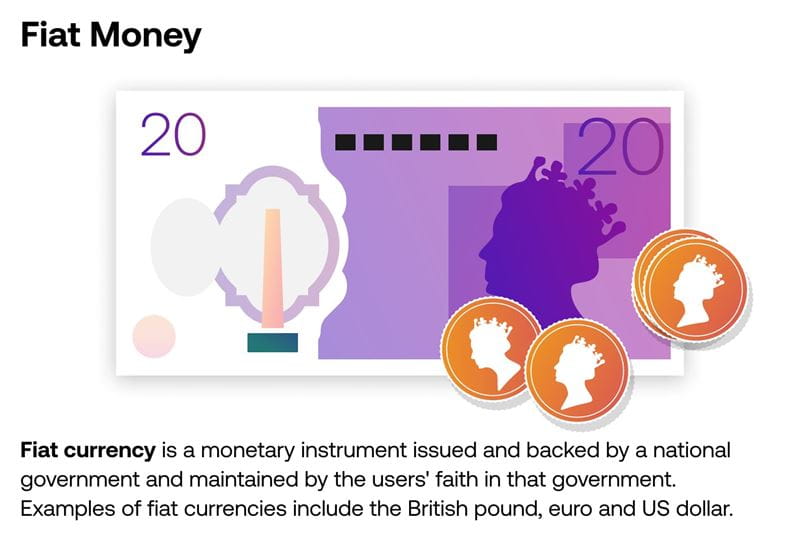
Fiat money vs representative money
Fiat money vs cryptocurrencies
What happens when a fiat currency collapses?
Pros and cons of fiat currency
What is fiat money?
Fiat money originated during the Chinese Tang dynasty in the 11th century as pieces of paper, each one being authenticated by government officials. The general principle of fiat money remains the same today. It gets its value from the backing of governments, allowing individuals and businesses to put their faith in it as long as they have faith in their government.
Fiat money includes any national currency whose value is derived from a country’s promise to back it, not from physical commodities like gold or silver. Fiat money is backed by the general public’s faith in a country’s central bank and the national government issuing that money. If a country were to become insolvent, its fiat currency would drastically lose value.
The value of fiat money is constantly shifting. The ever-changing value of fiat currencies is shown in foreign exchange, the global marketplace for exchanging national currencies.
Why is it called fiat currency?
The word ‘fiat’ is a Latin word meaning determination by authority. For fiat currencies, value is determined by authorities like national governments and central banks.
Examples of fiat currency
Popular examples of fiat currencies include the euro, Japanese yen, US dollar and pound sterling. Nearly all national currencies are fiat currencies, although the value of many currencies are linked directly to the export of a nation’s commodities.
For example, the Russian ruble and Canadian dollar are both strongly influenced by the price of oil. However, they are still considered fiat currencies because each individual ruble or dollar is not backed by a physical barrel of oil.

Fiat money compared to other currencies
Money as a financial instrument can be classified as one of three forms. While there are other derivative products that have monetary value, they do not function as immediate forms of payment that can be transferred for goods and services.
Fiat currency vs commodities
Commodity money is the oldest financial instrument. Forms of commodity money have been salt, beads, seashells, tobacco, silver, and gold. The invention of commodity money allowed for a standard system of trade among and between civilizations. Unlike forms of money to be developed later, commodity money has a tangible store of value. It can be seen and touched, and the proven value of its physicality is what gave users trust in it.
Fiat money vs representative money
Representative money is a government-produced instrument backed by a commodity or fiat currency. Examples of representative money include checks and credit cards. Typically, representative money is a placeholder when the user intends to pay at a later date. Like fiat money, representative money does not have intrinsic value. Its value is instead derived from the financial institutions that uphold it.
Fiat money vs cryptocurrency
Cryptocurrencies are digital monetary instruments that can be created by private or public entities as well as national governments. The value of any cryptocurrencies is dependent on the speculation of those who hold the crypto and what price they choose to buy and sell the currency at. This speculation creates extreme volatility in crypto markets, behaviour that governments controlling fiat currencies try to avoid.
How can I trade fiat currency?
You can trade one country’s fiat currency for another on the foreign exchange, or forex, marketplace. The forex marketplace is a global market that runs 24 hours a day. Anyone can exchange one currency for another at the current rate between two different fiat currencies.
You can learn more about trading currencies and how two different currencies are quoted and exchanged in our forex trading academy.
With City Index you can trade forex 24 hours a day, five days a week – from 10pm (GMT) on a Sunday evening to 10pm (GMT) on a Friday night. You’ll have the choice of trading 90 global FX pairs with competitive spreads.
Log in to your City Index account or open an account to start trading today.
Alternatively, you can open a demo account and practise trading fiat currencies. Read about the ten best forex pairs to trade and our list of the strongest fiat currencies in the world.
Understand the pros and cons of fiat money
Like all types of currency, fiat money comes with advantages and disadvantages.
Advantages of fiat money
Fiat money is easy to carry and exchange, which is why countries adopted fiat in the first place. Paper notes are cheap to produce and have no limit to the amount that can be printed—unlike commodities which often experience scarcity. This gives governments tighter control over the flow of fiat money, allowing them to more closely manage economies through interest rates and credit supply.
Disadvantages of fiat money
The disadvantageous of fiat money are tied to its mutability. Governments can and do mismanage their economies, resulting in hyperinflation, bubbles and other economic meltdowns. Fiat currency is also more susceptible to counterfeit than commodities or cryptocurrencies.
What happens when a fiat currency collapses?
Because fiat currencies are not backed by a physical commodity, they are at risk of collapsing during an economic bubble. An economic bubble occurs when fiat currencies rapidly increase in value until the heightened price becomes unsustainable. When a currency becomes too highly valued, other countries cannot afford it, and in turn, the overvalued currency rapidly loses value. Hence the idea of a bubble bursting.
Fiat currencies FAQs
What is the safest fiat currency?
The safest fiat currency is often considered to be the Norwegian krone because Norway has zero debt. Norway’s own economy is also quite stable compared to other countries. However, those conditions do not make the krone immune to inflation or bubbles.
Other safe currencies include the Japanese yen, United States dollar and Swiss franc. Japan and the United States both have strong positions in the global economy that ensure their currencies will bounce back from economic hardship quicker than other countries. Switzerland’s neutrality in global conflicts, low debt levels and strong monetary policies make the franc a safe haven currency.
Is Bitcoin a fiat currency?
Bitcoin is not a fiat currency because it is not issued by a government or regulated by a central authority. Instead, Bitcoin and other cryptocurrencies are backed by blockchain technology. Cryptocurrencies like Bitcoin are decentralized, meaning no single authority controls their supply or value.
Is gold a fiat currency?
Gold is not a fiat currency. Rather gold is a perfect example of a commodity currency. It has tangible value because of the demand for gold in jewellery and manufacturing in addition to the resource’s scarcity.
Gold is still traded today for fiat currency as a way to store wealth or speculate on the changing value of both. Learn more about gold and silver and how they are traded with fiat currencies.
What is fiat currency backed by?
Fiat currencies are backed by a country’s government. Their value rises and falls with the country’s position in the global economy. Two main factors that affect a fiat currency’s value are international trade and government stability.
Is fiat currency illegal?
No, fiat currencies are legal. Although fiat currency is used in most money laundering crimes and other illegal trades compared to other forms of money.




